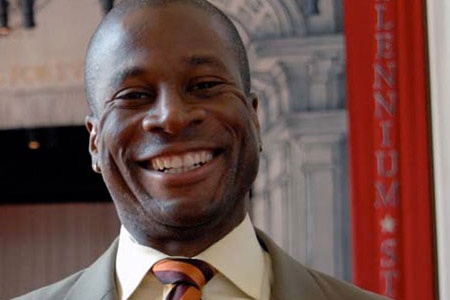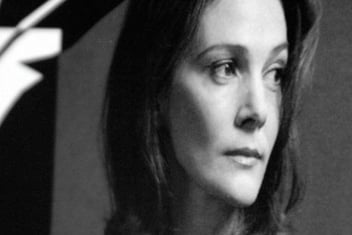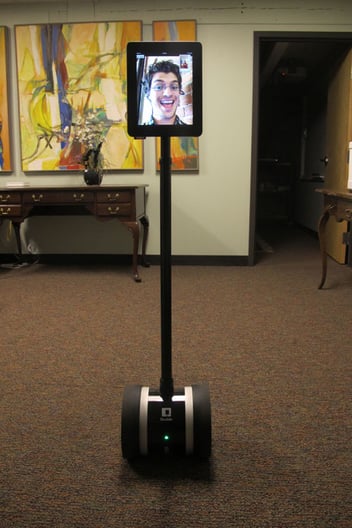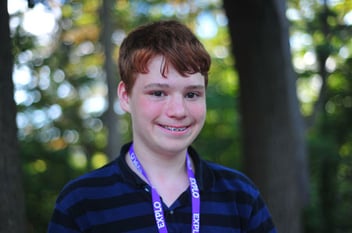Ramien Pierre: Ambassador for the Arts
Lauren Frazier
June 26, 2012

Ramien Pierre [Explo Faculty '93-'96] talks about his role facilitating the arts at the Kennedy Center.
Ramien Pierre [Senior Faculty '93, Junior Faculty '94-'98] started at Exploration in 1993 as an instructor in international studies. The next year, he worked in the Programming Office, where he stayed for three years, eventually becoming Head of Programming. Since his time at the Explo, Pierre has gone on to Washington, DC, and has launched a career in advocating for the arts and arts education. He has worked with Projects in Active Cultural Engagement as a consultant to the Duke Ellington School of the Arts, and as the executive director of the Dance Institute of Washington, where he founded the group’s professional modern dance company. Today, Pierre works at the Kennedy Center for Performing Arts as an Education Department administrator.David Hamilton, Exploration's Director of Publications, caught up with Pierre while taking a tour of the Kennedy Center. What follows is an excerpt from their conversation.
David Hamilton: I’ve been reading the Kennedy Center website. And when you Google “Kennedy Center,” the first thing that comes up is “America’s National Cultural Center,” and I read that and think, “Wow, that’s a tall order.”
Ramien Pierre: You didn’t know you had one.
DH: That’s a lot of pressure, you know, if you are now the “National Cultural Center of America.”
RP: I think internationally we’re much more seen than nationally, is my sense. For example, this afternoon, I’m meeting with some Serbians. And for most of them, it seems the part they’re most fascinated by is the history of philanthropy in the United States, in terms of the arts. We always talk about it as something that’s evolved naturally out of an embarrassment. You know, Puritans thought music and dance was evil, so, therefore, there’s never been the state support for the arts.
DH: What percentage of what the Kennedy Center does is for in-house concerts and performances versus outreach or things to support the nation culturally?
RP: That’s hard to quantify. As a center, we do just over 3000 performances a year here, in the building.
DH: Wow. That’s a huge number.
RP: It is. It’s almost ridiculous.
DH: In terms of outreach, I know about some of the programs.
RP: Locally, we do workshops for teachers; we do programs where we bring students here; we do residencies where we put artists in schools. We do training for young dancers, ballet dancers, young classical musicians, jazz musicians. And then the other piece we do, in terms of training, is arts management training. That’s my piece here. I help coordinate all of the arts management training programs.
DH: What is the role of an arts manager?
RP: Somebody who’s not a performer, but who makes the rest happen. Usually the executive directors, artistic directors. Mostly we work with executive directors.
DH: In terms of training, are you training them how to do their job or are you training them how to develop new ideas?
RP: It’s a little of both. For most of these people – since arts management as a field, as an academic discipline, is rather new – they don’t have degrees in arts management. Whereas there are tons of resources to train artists, there aren’t really a lot of resources to help people be leaders of small arts organizations. And arts organizations have a particular challenge that most small businesses don’t. It’s a productivity challenge. To say briefly, take the car industry. The car industry, they’re able to produce more cars with fewer resources every year. They figure out a way to squeeze more cars out of each worker, or do the same amount of work more cheaply. But that doesn’t work in the arts. Because the number of dancers you need to create Swan Lake today is exactly the same as the number of dancers you needed when Swan Lake was created. You can’t do it with fewer people.
DH: And a theater has a limited capacity, so even if you sold out every show last year, you can’t—
RP: Exactly. Revenue is capped. . . The challenge becomes negotiating with unions to get rights to a piece in a way that’s cost effective. The challenge [is that] the national offices have set up requirements that actually make it harder for the leaders of arts organizations to work with local artists to expose more people to their work. My personal opinion is that the symphony orchestra is going to have a very, very hard time existing in the next 25 or 30 years unless orchestra unions are more flexible about how much or how little they will charge arts organizations for the rights to works. You know, I would love to have us create more educational internet components for the National Symphony Orchestra that’s housed here, but we just can’t afford to do it and still pay the union and the orchestra.
DH: That’s really interesting. I didn’t even think of that.
RP: It’s a little bit of cutting off your nose to spite your face. You get money today, but you almost guarantee that fewer people are going to see you, or hear you, so there’s no sense that you’ll have money tomorrow. Because there’s no audience building, because public education is cutting back on the amount of arts. . . . Even DC in particular there’s a 30% chance in most of the wards of the district that you will not have an art teacher if you’re in elementary school, and when you get across the river to Wards 7 and 8, which are the less wealthy wards, I think it goes up to 70%. Kids are just not getting exposed to art.
RP: Programmatically, my life centers around these arts management programs and making sure everything is going smoothly. And this sort of new piece, which is really—we haven’t really called it anything—but I think it ends up being cultural diplomacy. A lot of people don’t know that the U.S. Department of State has donated a significant amount of dollars and energy to bringing in groups of artists, developing good relationships with other countries through artists. So for this last year, for example, we brought in six groups of 24 artists from countries with significant Muslim populations, basically for artist training.
DH: When you say “artists,” we’re talking about dancers and musicians? Or is this visual art?
RP: We had visual artists from Egypt; classical musicians form Azerbaijan; film critics from Kazakhstan; dancers from India; and musicians from Lebanon, who would probably have to be classified as “new music” musicians. It was kind of out there.
DH: That’s a breadth of stuff. You’re not just talking about pianists, for example. You’re talking about a lot of variety.
The Kennedy Center [hosts] visual artists from Egypt, film critics from Kazakhstan, and 'new music' from Lebanon. Pierre describes this part of his work as developing relationships with other countries through artists.
DH: Wow, that’s great.
RP: So, I’ve become a cultural diplomat without knowing it.
DH: That’s exciting, though.
RP: It is. It’s sort of terrifying.
DH: You've spoken briefly about some of the programs that you sponsor. There’s a couple that stood out to me when I was reading the website: the DC Schools Partnerships and the Duke Ellington School.
RP: Yeah, DC Schools Partnership—
DH: Is that what you’re talking about in terms of local support? That part of the mission?
RP: Yes. Yes. There are 18 schools in the DC partnership, including Ellington. The idea is to develop and sustain relationships with a certain number – in this case, I guess, 18 – DC elementary and middle schools. Like I was saying, all arts teachers in DC come under the discretional funding category, so principals decide whether they have an arts teacher or a reading specialist. Because of No Child Left Behind, many are choosing reading specialists, for example, as opposed to art teachers. So the idea is, let’s provide resources to local teachers and students. Instead of having one opportunity, where kids come in and see a show and we never see them again, let’s sustain a relationship with the same schools over and over and over again, doing multiple things.
DH: That’s interesting. One of the phrases on your site that I responded to is, “The arts have unlocked a door for learning for young people, challenging students to think in new ways.” Who is a student in the mind of the Kennedy Center?
RP: Young people and adults, though I would say K-12 is our main focus. I know we believe that the arts can hold some value for people regardless of age. For example, I know that I got here September 6, 2001 – so the whole September 11th thing happened just a few days after I got here – and the Center made a commitment at the time to keep moving, that the show would go on. The reasoning at the time was, you know, it seems that at times when life is hard, that’s especially when you need some good art.
DH: I went to Cirque du Soleil that night, I’m embarrassed to say. My wife had tickets, and we found ourselves sitting around the house saying, “We can’t go, we need to stay here,” and at some point we were like, “What are we going to do here?”
RP: Were there other folks there?
DH: The place was packed. And I thought they treated it very well. I mean, they didn’t know what to do either; nobody knew what to do. They came out, and they observed almost a full five minutes of silence and then began the performance. And they said almost that exactly – the show must go on, essentially.
I believe that human beings are social creatures and that the power of live performance is in large part because you're taking in a moment with other folks.



